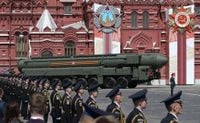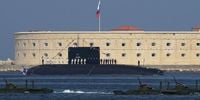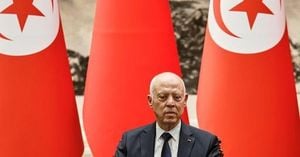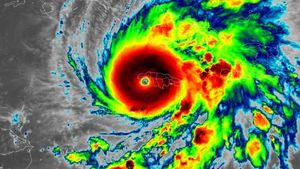Norway’s Defence Minister Tore Sandvik has issued a stark warning to NATO and its Western allies: Vladimir Putin is amassing a formidable nuclear fleet just miles from NATO’s northern border, signaling what Sandvik describes as “preparation for war.” The buildup, centered on Russia’s Kola Peninsula, has triggered alarm across the alliance, with officials in Oslo describing a dramatic escalation in Moscow’s Arctic military posture and a chilling reminder of the region’s strategic importance in any East-West confrontation.
According to The Daily Telegraph and corroborated by MailOnline and Newsweek, Sandvik revealed that Russia is not only increasing the number of nuclear warheads and attack submarines stationed in the Arctic Circle, but is also actively testing next-generation weaponry. “Russia is building up on the Kola Peninsula…where one of the largest arsenals of nuclear warheads in the world is located,” Sandvik told The Telegraph. He added, “They [the nuclear weapons] are not only pointed towards Norway, but towards the UK and over the pole towards Canada and the US.”
The Kola Peninsula, which has served as the home of Russia’s Northern Fleet since 1733, now plays a far more ominous role than its original purpose of safeguarding fisheries and trade. Sandvik emphasized that the fleet’s presence, and the concentrated nuclear arsenal there, provide Moscow with a robust ‘second strike’ capability—a nation’s ability to retaliate even after sustaining a nuclear attack. This, he argued, cements Russia’s status as a nuclear superpower, even as its ground forces have suffered staggering losses in Ukraine.
“Even though Putin is losing heavily in Ukraine—he has lost one million soldiers—the Northern Fleet is intact. And they are developing it,” Sandvik explained to The Telegraph. Over the last two years, Russia has launched a new frigate and a multi-role submarine, further modernizing its Arctic forces. According to Newsweek, Sandvik stressed, “The most threatening thing about Russia right now is its submarines. Even though Russia is not able to win in Ukraine, the threat of nuclear warheads and second strike capacity from up here [Kola Peninsula] makes them a superpower still.”
The heightened activity is not limited to bolstering numbers. Norwegian intelligence has observed Russia conducting tests of hypersonic missiles, nuclear-driven torpedoes, and new nuclear warheads. “We are the eyes and ears of NATO in this area, and we see that they're testing new weapons, for example hypersonic missiles, and they are testing nuclear-driven torpedoes and nuclear warheads,” Sandvik stated, as reported by multiple outlets.
These developments come at a time of increased geopolitical tension, with relations between Moscow and the West at their lowest point since the Cold War, following Russia’s full-scale invasion of Ukraine in February 2022. Western leaders, including former President Trump, have responded with new waves of sanctions targeting Russian oil giants and vocal demands for a ceasefire—demands that have so far gone unheeded by the Kremlin.
But why the Arctic, and why now? Melting ice caps are opening up new shipping routes between Europe and Asia, making the region more economically and strategically valuable than ever before. Sandvik explained that Putin’s ambitions in the Arctic go beyond simply defending Russian territory; they are about dominating the region and blocking vital naval routes that NATO would rely on in the event of a wider conflict.
Central to this strategy are two narrow maritime chokepoints: the Bear Gap and the GIUK Gap. The Bear Gap separates mainland Norway from the island of Svalbard—a critical passage for Russian vessels seeking access to the Atlantic Ocean. The GIUK Gap, meanwhile, lies between Greenland, Iceland, and the United Kingdom, and has long been recognized as a linchpin for naval control in the North Atlantic. “Putin needs to establish what is called the Bastion defence. He needs to control the Bear Gap to make sure that he can use his submarines and the Northern Fleet. And he wants to deny [NATO] allies access to the GIUK Gap,” Sandvik told The Telegraph.
Norwegian officials, acting as NATO’s “eyes and ears” in the Arctic, have repeatedly sounded the alarm about the risk posed by Russia’s military buildup. The Kola Peninsula’s proximity to NATO territory means that any escalation could quickly draw in Britain, Canada, and the United States—all of whom are within range of the nuclear weapons now pointed in their direction, according to Sandvik.
Despite the heavy toll of the Ukraine war on Russian ground forces, the resilience and modernization of the Northern Fleet stand out as a testament to Putin’s priorities. “They have a new frigate and a new multi-role submarine, developed just in the last two years,” Sandvik said. “Even if we have a peace deal in Ukraine, with boots on the ground and a stable situation, one analysis is that he will mobilise millions of soldiers up close to the border with Finland.”
The strategic significance of the Arctic is nothing new. As Jamie Kwong of the Royal United Services Institute noted in a 2018 analysis, both the US and Soviet Union have long recognized the region as a potential flashpoint, with regular nuclear submarine patrols beneath the Arctic’s icy surface. The current standoff, however, is marked by the added urgency of climate change, technological advancements, and the specter of renewed great-power competition.
For its part, the West faces a daunting challenge. The prospect of Russia establishing control over key Arctic passages could severely hamper NATO’s ability to reinforce its northern flank in a crisis. The testing of hypersonic missiles and nuclear torpedoes adds a further layer of unpredictability to an already volatile situation.
Perhaps most troubling, in Sandvik’s view, is that Putin shows little interest in any form of lasting peace. “Putin is not interested in peace...Putin’s plan is not a stable peace with Ukraine. If he can, he will come back,” the Norwegian defense minister warned. The implication is clear: even if the guns fall silent in Ukraine, the threat from the north will remain, and vigilance in the Arctic will be more crucial than ever.
As the world’s attention remains fixed on the battlefields of Ukraine, the silent buildup in the Arctic may well prove to be the defining contest of the coming decade. The choices made in the icy waters off Norway’s coast could shape the security of Europe—and the world—for years to come.





